Tuesdays with Tony
Platelet Rich Plasma (PRP)
In my recent blog about tendinitis, I told you about a really cool tool my docs have to treat your horse’s tendon injury – Platelet Rich Plasma (PRP). Today, we’ll talk about how that stuff works and how we use it to treat not just tendon and ligament injuries, but joint disease and even wounds. PRP has the amazing ability to deliver molecules that optimize healing for faster, and more importantly, better quality repair tissue. The best part about using PRP is that it’s a product from your horse’s very own body helping him heal…specifically, the platelets in his blood.
Horses (like you and I) have little cell fragments called platelets that zoom around in the bloodstream along with the red blood cells that carry oxygen and the white blood cells that fight infection. Platelets form blood clots when an injury occurs and help during wound healing. They contain large amounts of growth factors – molecules that send signals to form new blood vessels, bring in cells, and stimulate tissue regeneration. These growth factors are the reason we want the platelets – they give your horse the healing boost.
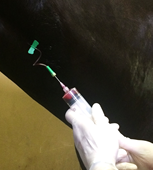 Sometimes, there are downsides to using medications. For example, steroids come with risks and may not be right for every horse with an arthritic joint. Platelets, on the other hand, are a super powered healing force your horse already has inside him. What my docs do is make a super-concentrated version called PRP and inject it right where your horse needs it! It’s minimally invasive, can usually be done right at your farm, and is free from any chance of allergic reaction since it comes from your horse.
Sometimes, there are downsides to using medications. For example, steroids come with risks and may not be right for every horse with an arthritic joint. Platelets, on the other hand, are a super powered healing force your horse already has inside him. What my docs do is make a super-concentrated version called PRP and inject it right where your horse needs it! It’s minimally invasive, can usually be done right at your farm, and is free from any chance of allergic reaction since it comes from your horse.
What do we treat with it?
PRP was developed and tested out on humans before being tried on higher forms of life, like cats (and horses, I guess). It was first used in the 1970’s to improve healing after maxillofacial surgery. Since then, lots of clinical trials and research have been performed, both in people and in animals. Equine studies indicate that tendon and ligament injuries treated with PRP have faster tissue healing times and reduction in lameness compared to untreated injuries. The chance of the horse re-injuring the tendon after he goes back to work decreases as well. My docs use PRP to treat tendon injuries (bowed tendons), suspensory and other ligament injuries, arthritis, joint inflammation, stifle soft tissue injuries like meniscus tears, and certain wounds.
How do we make PRP?
My doc will take a sample of blood from your horse’s neck and put it in some special tubes. Back at the clinic, the blood goes through a centrifuge process to remove most of the red and white cells. This concentrates the platelets in the plasma (the liquid part of the blood without the cells) and gives us the platelet-rich plasma product (PRP). This is all done in a sterile way. We often get several doses of PRP out of one sample of blood. The doses we don’t need immediately are stored in the freezer for future use.
How is it injected?
Now that we have the PRP ready to go, the next step is to get in into your horse. If your horse’s joint is the target, the process is just the same as if we were injecting it with steroids. My doc and her tech do a super sterile scrub to reduce the risk of infection. They don’t lick the spot clean like I would, they just use surgical scrub. Then my doc injects the PRP right into the joint.
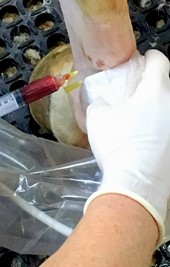 If it’s a tendon or ligament that your horse has injured, my doc will inject the PRP right into the damaged part, where the growth factors get to work stimulating regeneration of the fibers. First, my doc scrubs your horse’s leg to make sure it’s really clean (again, no licking). She puts in a little numbing agent so he doesn’t mind the injection. This next part looks really fun – kind of like playing a video game. She uses her ultrasound to place several needles into the injured tendon. She can watch on the ultrasound screen as she moves the needles right into the defect in the tendon. That way she can make sure the growth factors are going right where your horse needs them. (video here) She will place a bandage on your horse’s leg and talk to you about what kind of activity restriction and rehab he needs. That will depend on the kind of injury your horse has, so it will be tailored to his individual situation.
If it’s a tendon or ligament that your horse has injured, my doc will inject the PRP right into the damaged part, where the growth factors get to work stimulating regeneration of the fibers. First, my doc scrubs your horse’s leg to make sure it’s really clean (again, no licking). She puts in a little numbing agent so he doesn’t mind the injection. This next part looks really fun – kind of like playing a video game. She uses her ultrasound to place several needles into the injured tendon. She can watch on the ultrasound screen as she moves the needles right into the defect in the tendon. That way she can make sure the growth factors are going right where your horse needs them. (video here) She will place a bandage on your horse’s leg and talk to you about what kind of activity restriction and rehab he needs. That will depend on the kind of injury your horse has, so it will be tailored to his individual situation.
For more info about PRP and to talk about whether using your horse’s own super powered PRP would help him out, give my doc a call!
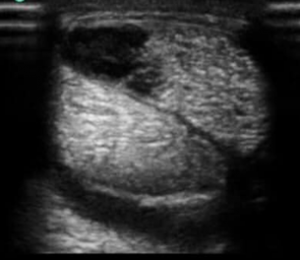
This is an ultrasound of an injured superficial digital flexor tendon. See the black hole on the left side? That’s the injured part where the tendon fibers are torn – it should look more like the right side.
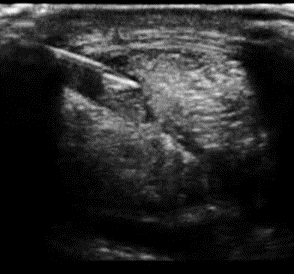
The needle is being placed in the tendon. It’s the bright white line entering at the top left. My doc can direct the needle right where the injury is.
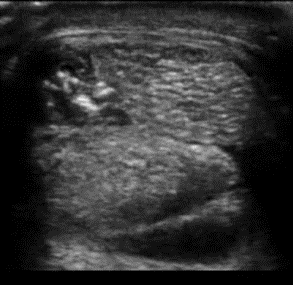
The PRP has been injected into the hole in the tendon. See those little bright white specks? Those are tiny air bubbles from the PRP injection. The PRP has filled the tendon injury nicely and the growth factors are getting to work!
Until Next week,
~Tony
Tuesdays with Tony is the official blog of Tony the Clinic Cat at Springhill Equine Veterinary Clinic in Newberry, Florida. If you liked this blog, please subscribe below, and share it with your friends on social media! For more information, please call us at (352) 472-1620, visit our website at SpringhillEquine.com, or follow us on Facebook!
[jetpack_subscription_form title="Subscribe to Whinny's Wisdoms"]

